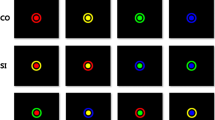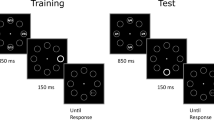Abstract
Electrophysiological recording in a temporal flanker task (i.e., distractors preceding the targets) has demonstrated that distractor processing is adjusted to the overall utility of the distractors. Under high utility, that is, distractors are predictive of the target/response, distractors immediately activate the corresponding response (as indicated by the lateralized readiness potential, LRP). This activation has been shown to be markedly postponed when the target predictably occurs delayed. To investigate the occurrence and time course of distractor-related response activation under conditions of unpredictable target onset, we randomly varied the stimulus-onset asynchrony (SOA) between distractors and targets and recorded the distractor-evoked LRP. When the distractor utility was high, an LRP occurred shortly after distractor presentation. In case of a long SOA the time course of this LRP was characterized by a drop back to baseline and a subsequent re-activation that reached a substantial level before target onset. These results suggest that distractor processing is characterized by sophisticated adjustments to experienced utility and temporal constraints of the task as well as by further control processes that regulate premature response activation.




Similar content being viewed by others
Notes
The choice of a processing strategy may be conscious or deliberate. However, this is not necessarily the case, because the selection of a particular strategy may reflect the operation of some adjustment mechanism that is not under conscious control. It may be extremely difficult to determine whether conscious or unconscious mechanisms are involved in a particular case. This is because there is no generally accepted criterion for determining whether a process is conscious or unconscious or whether a process is deliberate or not. We make no attempt in this article to address this issue. Thus, the use of the terms choice and selection by the subject is not intended to imply any involvement of the subject’s consciousness or free will.
Note that using this interval restricted the analyses to time windows before target-related motor activation had an effect on the LRPs, that is (according to Jost et al., 2017 and a reanalysis of the present data) around 550 ms in the short-SOA condition. Onset of the analyzed time window was set to 350 ms, which corresponds both to the onset of the LRPs (i.e., when contralateral activation differed significantly from ipsilateral activation) as well as to the utility effects in the study by Jost et al. (2017).
Note that an analysis based on mean instead of median RTs revealed similar results.
Our data leave the possibility, however, that inhibition of distractor processing was applied right from the start to prevent response activation from reaching a high level in the first place.
Note that there is another caveat with measuring inhibition by means of LRPs. A below-zero LRP is not in itself a measure of inhibition. As a difference wave, the LRP indicates relative hand activation. Note that a reversal of the LRP below zero would also show up when the alternative hand becomes activated, for instance, because the alternative response is more likely (which, however, is not the case in the present context).
We thank an anonymous reviewer for this suggestion.
References
Abrahamse, E. L., Duthoo, W., Notebaert, W., & Risko, E. F. (2013). Cognitive control in a dynamic environment: The asymmetrical list shifting effect. Journal of Experimental Psychology: Learning, Memory, and Cognition, 39, 1552–1562.
Botvinick, M. M., Braver, T. S., Barch, D. M., Carter, C. S., & Cohen, J. D. (2001). Conflict monitoring and cognitive control. Psychological Review, 108, 624–652. https://doi.org/10.1037/0033-295X.108.3.624.
Bugg, J. M., & Crump, M. J. C. (2012). In support of a distinction between voluntary and stimulus-driven control: A review of the literature on proportion congruent effects. Frontiers in Psychology: Cognition, 3, 1–16. https://doi.org/10.3389/fpsyg.2012.00367.
Eimer, M. (1993). Stimulus-response compatibility and automatic response activation: Evidence from psychophysiological studies. Journal of Experimental Psychology: Human Perception and Performance, 21, 837–854.
Eriksen, B. A., & Eriksen, C. W. (1974). Effects of noise letters upon the identification of a target letter in a nonsearch task. Perception & Psychophysics, 16, 143–149. https://doi.org/10.3758/BF03203267.
Eriksen, C. W. (1995). The flanker task and response competition: A useful tool for investigating a variety of cognitive problems. Visual Cognition, 2, 101–118. https://doi.org/10.1080/13506289508401726.
Gehring, W. J., Gratton, G., Coles, M. G. H., & Donchin, E. (1992). Probability effects on stimulus evaluation and response processes. Journal of Experimental Psychology: Human Perception and Performance, 18, 198–216. https://doi.org/10.1037/0096-1523.18.1.198.
Gratton, G., Coles, M. G. H., & Donchin, E. (1992). Optimizing the use of information: Strategic control of activation of responses. Journal of Experimental Psychology: General, 121, 480–506. https://doi.org/10.1016/0013-4694(90)90087-Z.
Hazeltine, E., Lightman, E., Schwarb, H., & Schumacher, E. H. (2011). The boundaries of sequential modulations: Evidence for set-level control. Journal of Experimental Psychology: Human Perception and Performance, 37, 1898–1914. https://doi.org/10.1037/a0024662.
Holender, D., & Bertelson, P. (1975). Selective preparation and time uncertainty. Acta Psychologica, 39, 193–203.
Hommel, B. (2000). The prepared reflex: Automaticity and control in stimulus-response translation. In S. Monsell & J. Driver (Eds.), Control of cognitive processes: Attention and performance XVIII (pp. 247–273). Cambridge: MIT Press.
Ille, N., Berg, P., & Scherg, M. (2002). Artifact correction of the ongoing EEG using spatial filters based on artifact and brain signal topographies. Journal of Clinical Neurophysiology, 19, 113–124.
Jost, K., Wendt, M., Luna-Rodriguez, A., Löw, A., & Jacobsen, T. (2017). Strategic control over extent and timing of distractor-based response activation. Journal of Experimental Psychology: Learning, Memory, and Cognition, 43, 326–333. https://doi.org/10.1037/xlm0000326.
Kunde, W., Kiesel, A., & Hoffmann, J. (2003). Conscious control over the content of unconscious cognition. Cognition, 88, 223–242.
Los, S., Kruijne, W., & Meeter, M. (2014). Outlines of a multiple trace theory of temporal preparation. Frontiers in Psychology, 5, 1058. https://doi.org/10.3389/fpsyg.2014.01058.
Machado, L., Guiney, H., & Struthers, P. (2013). Identity-based inhibitory processing during focused attention. Quarterly Journal of Experimental Psychology, 66, 138–159. https://doi.org/10.1080/17470218.2012.701651.
Machado, L., Wyatt, N., Devine, A., & Knight, B. (2007). Action planning in the presence of distracting stimuli: An investigation into the time course of distractor effects. Journal of Experimental Psychology: Human Perception and Performance, 33, 1045–1061. https://doi.org/10.1037/0096-1523.33.5.1045.
Mattler, U. (2003). Delayed flanker effects on lateralized readiness potentials. Experimental Brain Research, 151, 272–288.
Melara, R. D., & Algom, D. (2003). Driven by information: A tectonic theory of Stroop effects. Psychological Review, 110, 422–471.
Miller, J. (1998). Effects of stimulus-response probability on choice reaction time: Evidence from the Lateralized Readiness Potential. Journal of Experimental Psychology: Human Perception and Performance, 24, 1521–1534.
Niemi, P., & Näätänen, R. (1981). Foreperiod and simple reaction time. Psychological Bulletin, 89, 133–162.
Requin, J., Brener, J., & Ring, C. (1991). Preparation for action. In J. R. Jennings & M. G. H. Coles (Eds.), Wiley psychophysiology handbooks. Handbook of cognitive psychophysiology: Central and autonomic nervous system approaches (pp. 357–448). Oxford: Wiley.
Schmidt, J. R. (2013). Questioning conflict adaptation: Proportion congruent and Gratton effects reconsidered. Psychonomic Bulletin & Review, 20, 615–630. https://doi.org/10.3758/s13423-012-0373-0.
Wendt, M., Luna-Rodriguez, A., & Jacobsen, T. (2014). Utility-based early modulation of processing distracting stimulus information. The Journal of Neuroscience, 34, 16720–16725. https://doi.org/10.1523/JNEUROSCI.0754-14.2014.
Wendt, M., Luna-Rodriguez, A., Kiesel, A., & Jacobsen, T. (2013). Conflict adjustment devoid of perceptual selection. Acta Psychologica, 144, 31–39.
Wyatt, N., & Machado, L. (2013). Distractor inhibition: Principles of operation during selective attention. Journal of Experimental Psychology: Human Perception and Performance, 34, 137–157. https://doi.org/10.1037/a0027922.
Funding
This research was supported by a grant from the German Research Foundation (Deutsche Forschungsgemeinschaft) WE 4105/1-2 to Mike Wendt. We thank Svantje Kähler and Jonas Pichol for collecting the data.
Author information
Authors and Affiliations
Corresponding authors
Ethics declarations
Ethical approval
All procedures performed in studies involving human participants were in accordance with the ethical standards of the institutional and/or national research committee and with the 1964 Helsinki Declaration and its later amendments or comparable ethical standards.
Informed consent
Informed consent was obtained from all individual participants included in the study.
Additional information
Publisher’s Note
Springer Nature remains neutral with regard to jurisdictional claims in published maps and institutional affiliations.
Rights and permissions
About this article
Cite this article
Jost, K., Wendt, M., Luna-Rodriguez, A. et al. The time course of distractor-based response activation with predictable and unpredictable target onset. Psychological Research 83, 297–307 (2019). https://doi.org/10.1007/s00426-019-01149-7
Received:
Accepted:
Published:
Issue Date:
DOI: https://doi.org/10.1007/s00426-019-01149-7




